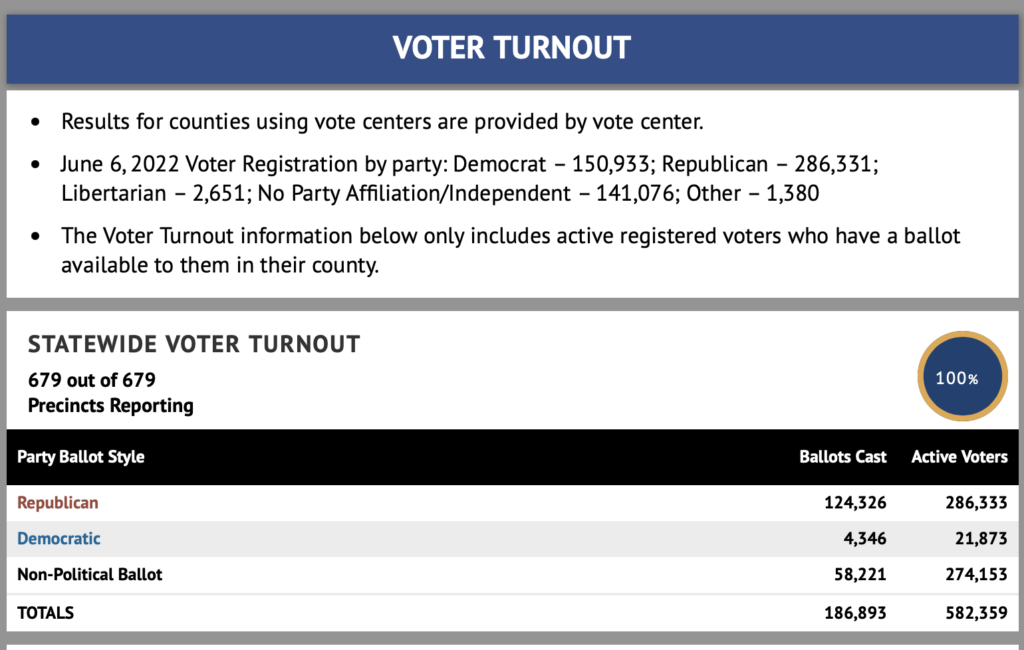The SDGOP pats itself on the back for turning out 43% of its voters for Tuesday’s primary. Yeah, historically notable, but still a majority of Republicans said with their parked bums that neither their primary candidates nor Amendment C were worth their effort.
But the SDGOP also makes up numbers about Democratic turnout:

Democratic turnout for Tuesday’s primary was low, and definitely lower than Republican turnout, but it was definitely not 2.8%.
The SDGOP refers to voter turnout data posted by the Secretary of State. Secretary Steve Barnett doesn’t actually post turnout for each party. Instead, the Secretary posts the total number of Republican primary ballots, Democratic primary ballots, and non-partisan ballots submitted on June 7:

Republicans had statewide primaries for U.S. Senate, U.S. House, and Governor. Thus, every Republican who showed up at the polls got a Republican ballot. 124,326 ballots out of 286,33 active Republican voters—that’s 43.42% Republican turnout.
Democrats had no statewide primary. Only four races had Democratic primaries: Sioux Falls House District 11 (2,177 votes cast), Rosebud House District 26A (614), Dewey County Sheriff (416), and Clay County Commission (2,457). The Secretary notes next to that figure that the number of active Democratic voters in those four discrete jurisdictions is 21,873. So in those four Democratic primaries, Democratic turnout was 19.9%—lower than overall GOP turnout, definitely not bragworthy, but definitely not 2.8%. The SDGOP ignored that figure specific to the places where Democratic ballots were available and instead divided by the number of active Democratic voters across the state, 150,933, which gives 2.879%, which the SDGOP incorrectly rounds down to 2.8%.
But hey: none of us are surprised that a party lad by Kristi Noem finds math difficult.
Districts 11 and 26A and Dewey and Clay counties were the only places where Democrats would have been handed Democratic ballots; everywhere else, Democrats would have been handed non-partisan ballots containing Amendment C and any local city council candidates, school board candidates, and/or ballot questions. So at least some of those 58,211 non-political ballots listed on the Secretary’s website went to Democrats and should be counted toward a calculation of turnout. The Secretary doesn’t offer such a count. The Secretary does offer numbers showing Democrats make up 50.98% of active non-Republican voters. I’m inclined to say Democrats probably showed up more enthusiastically to cast votes on Amendment C than did independents and other non-Republicans, but let’s stick with the facts on the page. If 50.98% of the non-political ballots were marked by Democrats, then the total Democratic turnout Tuesday would have been 29,678 non-political ballots + 4,346 Democratic ballots = 34,024, or 22.54% of Democrats, about eight times the turnout the SDGOP reports in its tweet.
I’m not celebrating either party’s turnout—any time a majority of voters sit out an election, we have a failure of civic pride and engagement that requires more education and mobilization. (Busy, schmusy! Get an absentee ballot.) But Republicans and Democrats alike both appeared to show more interest in this primary and in Amendment C than they did in the four preceding primaries, when Republican turnout ranged between 27% and 41% and Democratic turnout ranged between 13% and 16%.
South Dakota Republicans may tease South Dakota Democrats for not showing up at the polls in numbers as elephantine as the Grand Old Herd’s, but they should still tease us over the correct numbers, not their fast and misdirected math.

They were hoping we wouldn’t show up at all.
Indeed, Mr. H.
And few of us are surprised that when you blog under the enragement of NDS you find spelling in English difficult.
Unless, you mean a “party lad” like our common friend Mr. Brock, of course. Because nobody would call Mr. Rhoden a “lad.” Not if they wanted to keep their teeth.
Mr. Rhoden’s a lad.
Had to.
Nice Math poster, Mr. H. N nice, fat math.
all 150,993 registered Democrats had a ballot available with Amendment C on it, even if it had nothing else. Only 4,346 of them bothered to vote? That’s a voter turn out of 2.8%
you’re the one with the math problem.
The SDDP had few primaries because they can’t find candidates. Nobody wants to run for an office without a base of support, and there just isn’t one.
A remarkable leap of logic:
The premise – there are “150,993 registered Democrats;” conclusion – Democrats are “without a base of support . . . there just isn’t one.”
The logical question: How many “registered Democrats” are needed to make up an actual “base of support.”
bearcreekbat, nobody wants to run for office if they don’t have a lot of people backing them. You need money and volunteers.
I have personally been in the position of getting a phone call urging me to seek an office, telling me “if you run there will be a lot of people to support you,” and then the day of the convention arrives and they don’t show up.
It’s like that. Before you announce a candidacy you form an exploratory committee to see if anybody is willing to help. Will people circulate petitions? Donate money? Make phone calls, stuff envelopes, go door to door? You aren’t going to win an election without a base of support. That’s just a fact.